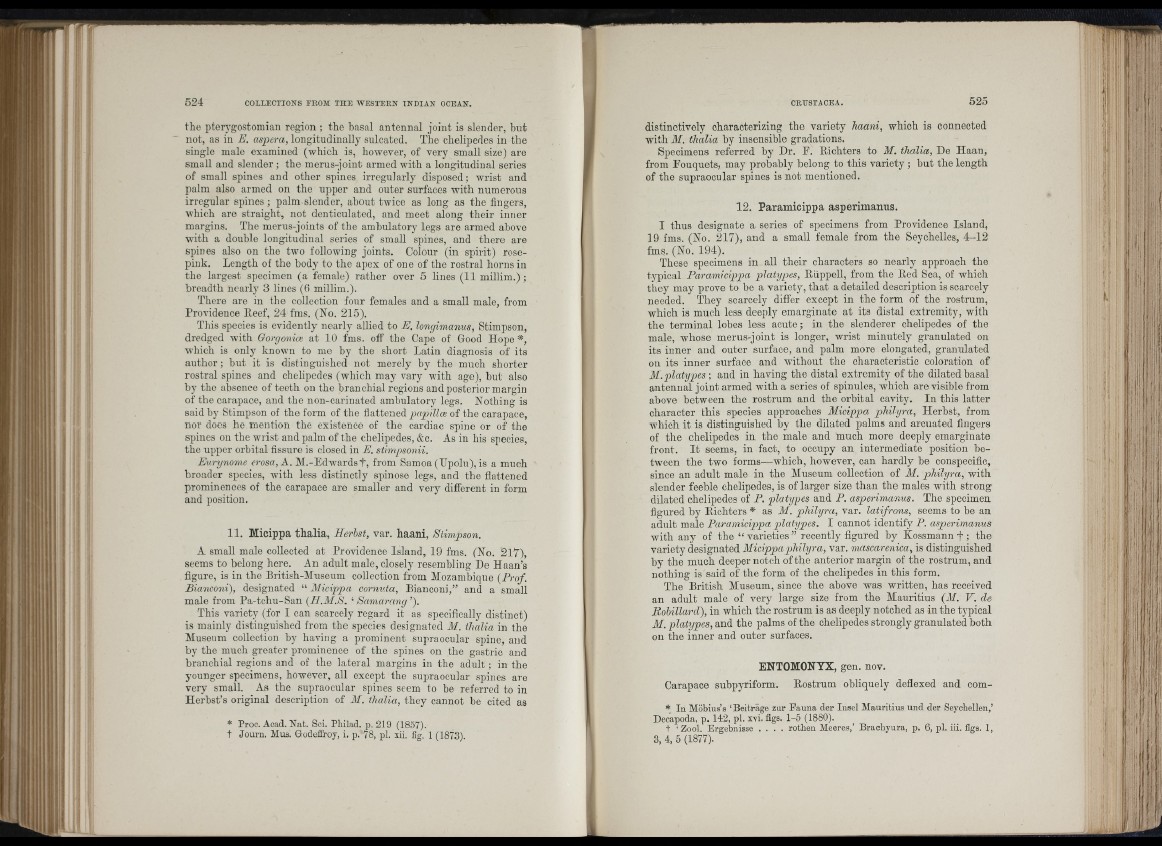
a iHl
the pterygostomian region ; the basal antennal joint is slender, but
not, as in E. aspera, longitudinally sulcated. The chelipedes in the
single male examined (which is, however, of very small size) are
small and slender ; the merns-joint armed with a longitudinal series
of small spines and other spines irregularly disposed; wrist and
palm also armed on the upper and outer surfaces with numerous
irregular spines; palm slender, about twice as long as the fingers,
which are straight, not denticulated, and meet along tbeir inner
margins. Tbe merus-joints of the ambulatory legs are armed above
with a double longitudinal series of small spines, and there are
spines also on the two following joints. Colour (in spirit) rose-
pink. Length of the body to the apex of one of the rostral horns in
tbe largest specimen (a female) rather over 5 lines (11 millim.) ;
breadth nearly 3 lines (6 millim.).
There are in the collection four females and a small male, from
Providence Eeef, 24 fms. (No. 215).
Tliis species is evidently nearly allied to E. longimanus, Stimpson,
dredged with Gorgonia. at 10 fms. off the Cape of Good Hope *,
which is only known to me by the short Latin diagnosis of its
author; but it is distinguished not merely by the much shorter
rostral spines and chelipedes (which may vary with age), but also
by tho absence of teeth on tbe branchial regions and posterior margin
of the carapace, and tbe non-carinated ambulatory legs. Nothing is
said by Stimpson of the form of the flattened papilla of the carapace,
nor does he mention the existence of the cardiac spine or of the
spines ou the wrist and palm of the chelipedes, &c. As in bis species,
tbe upper orbital fissure is closed in E. stimpsonii.
Eurynome erosa,A. Al.-Edwardsf, from Samoa (Upolu), is a much
broader species, with less distinctly spinose legs, and the flattened
prominences of tbe carapace aro smaller and very different in form
and position.
11. Micippa thalia, Herhst, var. haani, Stimpson.
A small male collected at Providence Island, 19 fms. (No. 217),
seems to belong here. An adnlt male, closely resembling De Haan’s
figure, is in the British-Aluseum collection from Alozamhique (Prof.
Bianconi), designated “ Alicippa cornv.ta, Bianconi,” and a small
male from Pa-tcbu-San (H.Al.S. ‘ Samarang’).
This variety (for I can scarcely regard it as specifically distinct)
is mainly distinguished from tbe species designated AI. thalia in the
Museum collection by having a prominent supraocular spine, and
by tbe much greater prominence of tbe spines on the gastric and
branchial regions and of tbe lateral margins in the a d u lt; in tbe
younger specimens, however, all except the supraocular spines are
very small. Aa the supraocular spines seem to be referred to in
Herbst’s original description of AI. thalia, they cannot be cited as
* Proc. Acad. Nat. Sci. Philad. p. 219 (1857).
t Journ. Mus. Godeffroy, i. p.'78, pi. xii. fig. 1 (1873).
distinctively characterizing tbe variety haani, wbicb is connected
with ilf. thalia by insensible gradations.
Specimens referred by Dr. E. llicbtera to AI. thalia, De Haan,
from Eouquets, may probably belong to tbis variety ; but tbe length
of the supraocular spines is not mentioned.
12, Paramicippa asperimanus.
I thus designate a series of specimens from Providence Island,
19 fms. (No. 211), and a small female from the Seychelles, 4-12
fms. (No. 194).
These specimens in all their characters so nearly approach the
typical Paramicippa platypes, Elippell, from the Red Sea, of wbicb
they may prove to be a variety, th at a detailed description is scarcely
needed. They scarcely differ except in the form of the rostrum,
which is much less deeply emarginate at its distal extremity, with
the terminal lobes less a cu te; in tbe slenderer chelipedes of tbe
male, whose merus-joint is longer, wrist minutely granulated on
its inner and outer surface, and palm more elongated, granulated
on its inner surface and without tbe characteristic coloration of
AI.platypes \ and in having the distal extremity of tbe dilated basal
antennal joint armed witb a series of spinules, which are visible from
above between tbe rostrum and tbe orbital cavity. In this latter
character this species approaches Micippa philyra, Herbst, from
which it is distinguished by tbe dilated palms and arcuated fingers
of the chelipedes in tbe male and much more deeply emarginate
front. I t seems, in fact, to occupy an intermediate position between
tbe two forms—wbicb, however, can hardly be conspecific,
since an adult male in tbe Aluseum collection of M. philyra, with
slender feeble chelipedes, is of larger size than the males with strong
dilated chelipedes of P. platypes and P. asperimanus. The specimen
figured by Richters * as M. philyra, var. latifrons, seems to be an
adult male Paramicippa platypes. I cannot identify P. asperimanus
witb any of the “ varieties ” recently figured by Kossmann f ; the
variety designated Micippa philyra, var. mascarenica, is distinguished
by the much deeper notch of tbe anterior margin of tbe rostrum, and
nothing is said of the form of the chelipedes in this form.
Tbe British Aluseum, since tbe above was written, has received
an adult male of very large size from tbe Alauritius (M. V. de
Pohillard), in wbicb tbe rostrum is as deeply notched as in tbe typical
M. platypes, and tbe palms of tbe chelipedes strongly granulated both
ou the inner and outer surfaces.
ENTOMONYX, gen. nov.
Carapace subpyriform. Rostrum obliquely defiexed and com-
* In Mobius’s ‘Beiträge zur Fauna der Insel Mauritius und der Seychellen,’
Decapoda, p. 142, pl. xvi. figs. 1-5 (1880).
t ‘ Zool. Ergebnisse . . . . rothen Meeres,’ Brachyura, p. 6, pl. iii. figs. 1,
3, 4, 5 (1877).
fl'
'J l!
+«mtd4ii’i
.i i f i
I ¡ I ' ! II (
I::'
J i
I'
ii ‘ teJ (
'' i
:.ï 'í^
i t